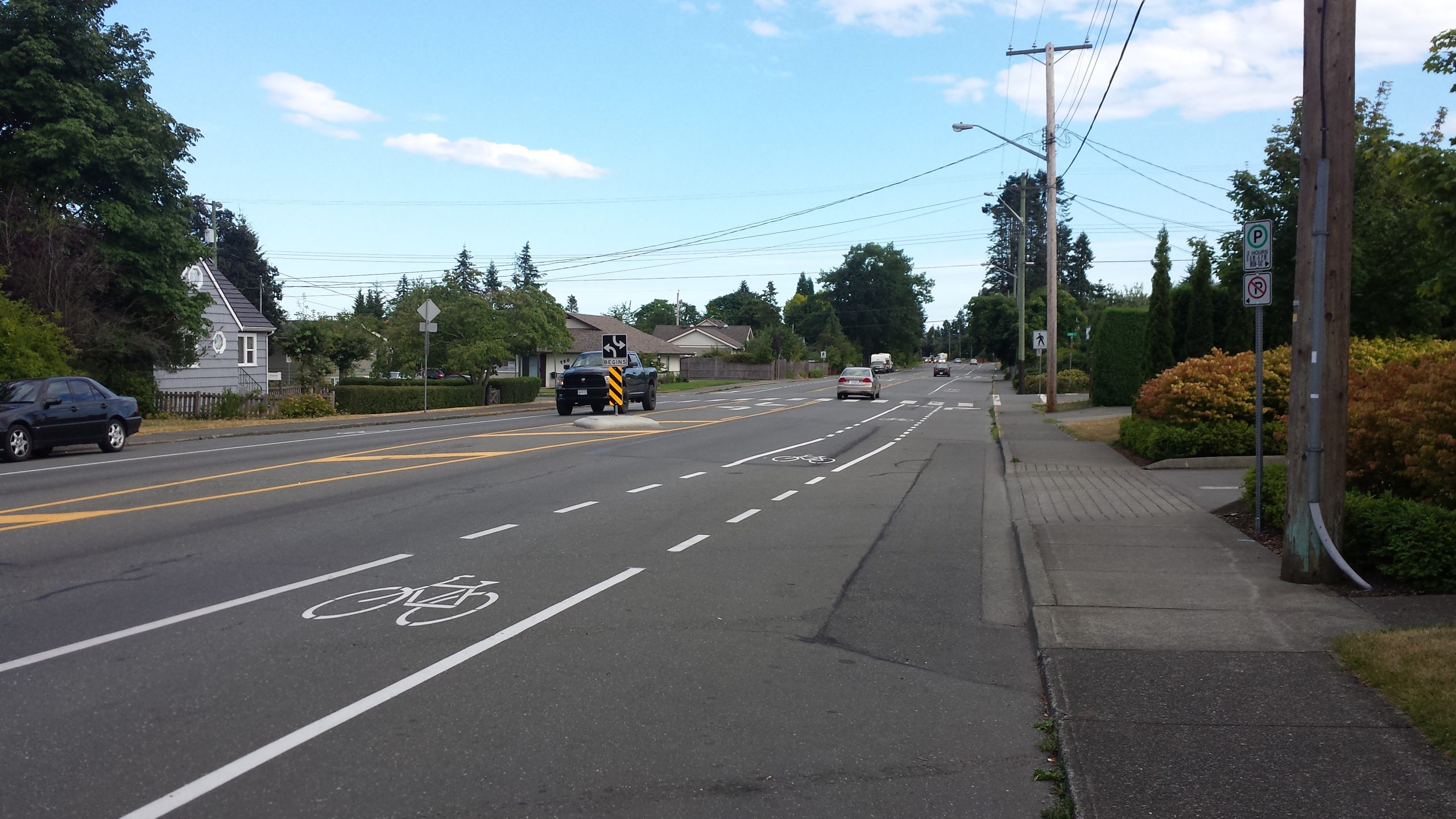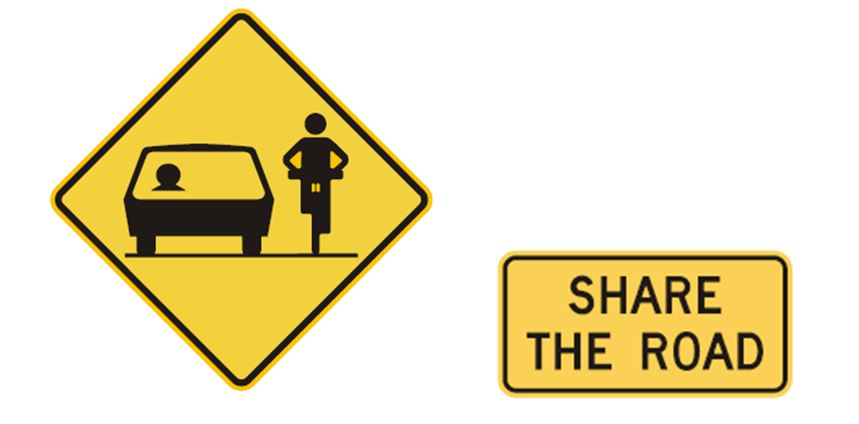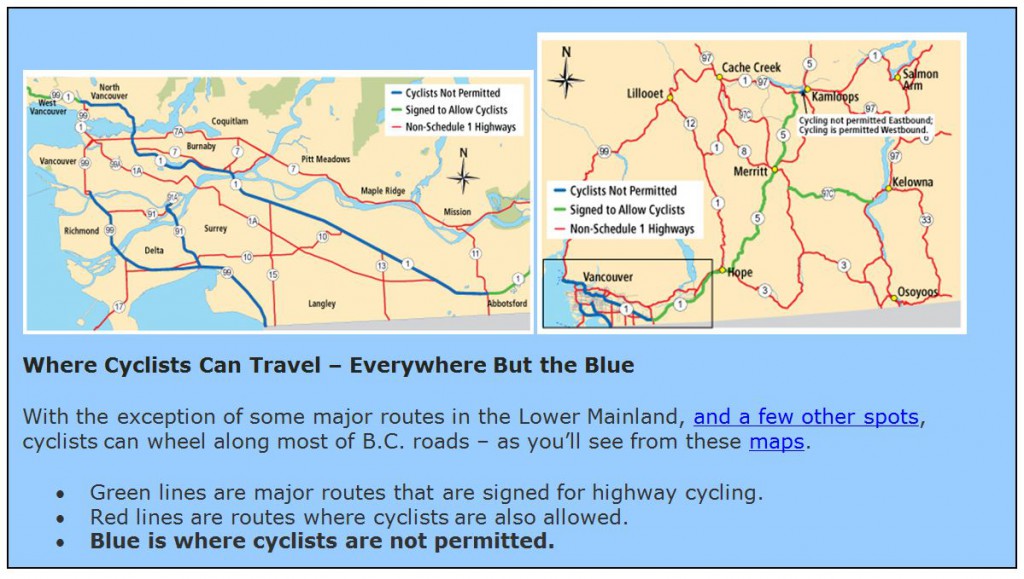Every year, an average of over 1,500 cyclists are injured in B.C. (This sad statistic is from ICBC).
Whether on fat tires or skinny tires, everyone driving and cycling, needs to share the roads and the responsibility for safety.
Cyclists are entitled to use the majority of provincial roads – from smaller two-lane highways around popular cycling destinations, to remote highways like the Stewart-Cassiar, to high-speed, high-volume routes like the Lougheed Highway (Highway 7). Plenty of people cycle provincial highways to commute to their jobs, whether in Northern B.C. and Vancouver Island, or the Lower Mainland and Southern Interior, and not just during Bike to Work Week. Plus cyclists pedal provincial highways for recreation, fitness, tourism and occasionally, competition.
In some places, the routes may not have shoulders or bike lanes. In others, they do. Wherever cyclists and drivers may be, here are 10 ways to savor the open road, stay aware of all types of travellers and keep safe.
Top Tips for Cyclist-Savvy Drivers on Highways:
- Don’t drive on the shoulders and don’t cut into the curve – there may be a cyclist (or pedestrian) around that bend.
- Watch for cyclists, if you’re turning onto the highway from a driveway or other road.
- Shoulder check before turning right, and scan for cyclists when turning left, to ensure you spot cyclists.
Top Tips for Cyclists on Highways:
- Keep your bike tuned up – especially before the season’s start and bigger bike treks. Do it yourself or turn your two-wheeled transport over to a bike mechanic.
- Before you launch, plan your route to travel bike lanes and paths as much as possible. Cycling routes can be found on Google Maps and many municipal websites.
- Be sure your bike’s headlight can be seen at 150 metres, and your rear red light and reflector is visible from 100 metres.
- Wear reflective gear to help keep you visible in all weather and at all times of day.
- Give your trusty helmet an occasional look over to ensure it will still protect you in a crash. (Of course you always wear your approved cycling helmet because you want to shield your head, plus it’s the law.)
- Stay tuned to what’s around you – not to ear buds. Look well ahead for hazards like gravel, potholes and wildlife.
- Watch for vehicles entering your route from other roads or laneways.
B.C. is a big, beautiful province for driving and cycling. No matter what your tire width, you can enjoy the open road and help keep everyone safe, by watching out for all types of wheeled transportation.
Have you checked out Active Transportation, where you’ll find loads of useful information, including how we’re working with communities to enhance cycling infrastructure?



Confused about the BC “Share The Road,” rule… does this mean an bike can take the entire lane of a 2-lane street that has extreme hills preventing drivers from viewing potential oncoming traffic? Or, is the rider to stay on the right side of the street allowing traffic to pass the rider? Thx
Hi Theresa, In the Motor Vehicle Act, cyclists are required to keep as far right as “practicable”. This means that generally, cyclists should ride on the right hand side of the lane, but it also means that they are not required to always be there. There may be good reasons for a cyclist to take the lane – in the example with hills, perhaps there isn’t sufficient lane width for a car to safely pass and with the hill, there also isn’t good sight distance. So, the cyclist in that situation takes the lane to prevent motorists from trying to pass unsafely (which could result in squeezing the cyclist off the road when a car coming the opposite direction is encountered). It all depends on the circumstances.
Why are cyclists not required to have liability insurance through ICBC? If I am hit by a person riding a bicycle whether I am a pedestrian or driving a motor vehicle what recourse do I have? I believe if cyclists were required to carry insurance then there would be better compliance with wearing helmets and obeying traffic laws as motorists do.
Hello Anonymous – thanks for connecting with us here. At present, the Province does not require insurance, licensing for cyclists in an effort to keep this mode of transportation open and accessible to people of all ages. All cyclists are required to follow the rules of the road, however and should you see any behaviour which is concerning, we encourage you to report it to the local authority having jurisdiction (BC RCMP, local municipal police) for their follow up. The BC RCMP and local enforcement, as well as ICBC regularly deliver road safety courses for cyclists, in an effort to educate cyclists on the rules of the road. We hope that this helps clarify.
Consider this scenario. An automobile in on a city street that has a bicycle lane on the right side. The driver of the auto approaches the intersection with his signal light on to turn right at the intersection but before he turns right a bicycle pulls up alongside the the auto between the auto and the curb. In this scenario, who has the right of way, the vehicle turning right, or the bicycle that is going straight through the intersection?
Hello Ken – thanks for your question. We did a quick search of the ICBC cycling safety webpages and found the following on this page: https://www.icbc.com/road-safety/sharing/Pages/cycling-safety.aspx
Yield to cyclists and signal well in advance if you need to cross a designated bike lane or pull over to the side of the road.
As the driver of the vehicle, you are required to yield to the cyclist.
Hope that this is helpful.
Thanks for this reply. I love to yield to bikes and pedestrians. However what if the vehicle turning right has no bike wanting to cross the intersection, then starts to turn and then a bike shows up from behind and freaks out because you are cutting them off. I think the bikes should approach every intersection and proceed with caution and not insist they maintain the speed in which they were riding unless the traffic is doing the same. The area this happened to me had a shared bike lane and sidewalk with the side walk displaying DONT WALK when some dumb ass on a bike almost ran into the back side of my vehicle. I stopped to let the screaming idiot ride by.
Ron:
Keep in mind that the bike lane marking changes to dashed in advance of the intersection. After that junction you should be breaching the bike lane to position as far right as possible before turning. Still you have to judge the speed of an approaching cyclist to ensure that you are not interfering with their right to proceed. A judgement many motorists misjudge especially when the cyclist is on an e-bike.
Cyclists are using the Orange Bridge in Nelson where there is no shoulder or room for other vehicles to pass safely. This slows traffic to a crawl. The issue is that its the only route to enter or exit Nelson and is heavily used by vehicles, especially during tourist season and also when the Kootenay Pass is closed. There are sidewalks running down either side of the bridge and I feel that it would be much safer to designate one of the sidewalks for cycles only and the other for pedestrians. I worry that the present situation is going to result in serious traffic snarls and is unsafe for cyclists. I noticed that there are signs being erected to warn drivers of “Cyclists on the Bridge”. This is a bandaid solution and will only cause more problems as cyclists are being given full reign to tie up traffic. Please urge the City of Nelson to accommodate the cyclists on one of the existing sidewalks!
Hello Randall,
Thank you for your message. We shared your comment and concern directly with our staff in the area and encourage you to share your concerns with the City of Nelson as well. Hope this is helpful.
Hello: I appreciate your advice on how to proceed with this safety concern. In August 2019, I wrote a letter to the City of Surrey, traffic@surrey.ca requesting consideration for pedestrian traffic along 8th Avenue, east of the Peace Arch traffic circle. A rapidly developed community called Douglas/Summerfield has formed between the two border crossings and south of 8th Ave. to 0 Avenue. This past winter, completion is coming also to a substantive new 605 children’s elementary school to serve South Surrey here. We have no local bus service requiring pedestrians to walk both ways along what is being called a provincial highway (8th) between hwy 99 and 196 Street (Hwy 15.). Moreover we have nowhere to walk safely for recreation. I am asking for consideration of plastic tube separators along 8th from 168 Street to 170 Street as that is the most challenging section where transport trucks gather tremendous speed and overshoot the road margin where pedestrians walk. Concrete barriers bar walkers from walking anywhere but the hwy. In addition road cyclists frequent this traffic area enroute to the country roads of Hazelmere. The expense of building a plastic barrier to visually guide drivers and prevent the overshoot would be a helpful safety measure. Long term, a better solution might be considered, but for now, this is a start. Thank you! Sandra Hartley sandy.hartley@shaw.ca, 778-292-1479
Good morning Sandra – thank you for your message. Just to confirm – did you hear back from the City of Surrey with your inquiry?
What signage is there for traffic to show there are no shoulders and you cannot pass bikes or pedestrian when there is oncoming traffic or obscured vision
Hi Jason,
Drivers are expected to know and follow the laws of the road, which include not passing cyclists (or farm equipment, or any other slow moving vehicles) when it is not safe to do so. There is signage to assist drivers and cyclist, however. We use “CYCLISTS ON ROADWAY” signs, picturing a vehicle next to a cyclist, to warn drivers that cyclists may be on the roadway. This sign is used where the presence of cyclists would be unexpected by the motorist, or where there tends to be heavy cycling traffic on the route. We also use centre lines (double solid and cautionary single solid) showing where passing in opposite lane is not permitted (former) or requires discretion (latter).
Hello
We live north of Qualicum near Corcoran Rd and I often run in to groups of cyclists taking up a full lane, if not the whole road. Just so I am clear, is it true they should ride single file and stay as far right as is safe ? It’s almost impossible to get past them sometimes when thye are slower than the speed limit which can be frustrating as it is a long road.
Thank you
Hi Julie,
Thanks for your question and for connecting with us here. According to section 183 of the BC Motor Vehicle Act, cyclists are required to ride single file and stay to the right in order to allow the movement of traffic on BC highways.
Rights and duties of operator of cycle
183 (1) In addition to the duties imposed by this section, a person operating a cycle on a highway has the same rights and duties as a driver of a vehicle.
(2) A person operating a cycle
(a) must not ride on a sidewalk unless authorized by a bylaw made under section 124 or unless otherwise directed by a sign,
(b) must not, for the purpose of crossing a highway, ride on a crosswalk unless authorized to do so by a bylaw made under section 124 or unless otherwise directed by a sign,
(c) must, subject to paragraph (a), ride as near as practicable to the right side of the highway,
(d) must not ride abreast of another person operating a cycle on the roadway,
(e) must keep at least one hand on the handlebars,
(f) must not ride other than on or astride a regular seat of the cycle,
(g) must not use the cycle to carry more persons at one time than the number for which it is designed and equipped, and
(h) must not ride a cycle on a highway where signs prohibit their use.
Are bicycles required to travell in single file as apposed to grouping up as though they were in the Tour DE France.
Hi Phil,
Great question. According to the BC Motor Vehicle Act referenced below, yes, they must ride single file.
Rights and duties of operator of cycle
183 (1) In addition to the duties imposed by this section, a person operating a cycle on a highway has the same rights and duties as a driver of a vehicle.
(2) A person operating a cycle
(a) must not ride on a sidewalk unless authorized by a bylaw made under section 124 or unless otherwise directed by a sign,
(b) must not, for the purpose of crossing a highway, ride on a crosswalk unless authorized to do so by a bylaw made under section 124 or unless otherwise directed by a sign,
(c) must, subject to paragraph (a), ride as near as practicable to the right side of the highway,
(d) must not ride abreast of another person operating a cycle on the roadway,
They do it all the time on the cycling roads in Vancouver, 7th,10th…. Then they yell when I honk and want to pass. How do we educate the new cycling public? I had a course in grade 2 that taught us the rules of the road. 1969.
Hello! RCMP continue to provide school aged training for young riders to make them aware of the rules of the road, as they did back in the day. ICBC continues to promote safe cycling habits (which includes motorist awareness) through their channels as well. https://www.icbc.com/road-safety/sharing/Pages/cycling-safety.aspx
Hello again Jeff,
Here’s what we heard from the Commercial Vehicle Safety Enforcement officers: Regardless of the license they have, the maximum length of an RV allowed in BC is 41 foot ( 12.5 metres). There are no permits available to exceed that maximum length.
We hope that this is helpful.
I second what Dave says above. Share the Road signs are ambiguous and actually rather dangerous. It is time to change them for signs that say “Bikes may use Full Lane”.
I live on Hornby Island and our roads are too narrow for a car to pass a bike in the same lane. We have very rough and uneven shoulders and narrow two lane roads. But we have many, many visitors in the summer and many tourists with bicycles. It makes for a very unsafe environment if the drivers don’t understand that they cannot pass bikes in the same lane!
Please take this seriously.
Thank you,
Barbara
Hi Barbara,
Thanks for connecting with us here and sharing your concern. We have shared your comment with our Traffic Engineers for review. Thanks again!
The “share the road” signs are outdated as studies have found that the perception of many drivers is that bikes should not be on the road and their idea of “share the road” is that bikes should be in the dirt and I don’t have to give them space. Better signs would clearly describe the amount of space drivers should give the bikes or that bikes “may use full lane” as some places in the USA have done. http://journals.plos.org/plosone/article?id=10.1371/journal.pone.0136973
Hi Dave,
Thanks for connecting with us here and sharing this. We have forwarded your comment to our traffic engineers for review.
I don’t agree, the roads were built and paid for by the cars. If the cyclists want there own roads they should pay for it.
Hello Fraser – thanks for your comment. The money to build and maintain roads does not come specifically from motorists, rather from all British Columbians, through their tax contributions. We receive a portion of that amount (our annual budget) to maintain and improve highways for all users, wherever possible. Hope that this information is helpful. Safe travels.
I think all cyclists should have rear view mirrors so that you know what is going on behind them. I use one mounted on my helmet so by twisting my head a little I can scan a broad scene. Here in the Interior we have lots of logging trucks. Say you’re cycling toward an inter section leading into the mills. Looking in your mirror you see a logging truck coming and you can see that its got its right signal light on. No sense trying get through the intersection first. You can slow down or maybe even stop to let it make its turn. Maybe someday you’ll hear a vehicle coming up behind you with a siren on. A glance in your mirror and you’ll know to pull over and stop. Checking your rear view mirror often will prevent sudden surprise when something over takes you; like an electric scooter! They don’t make any sound! But you`ll have seen it coming in your mirror! Have a great safe summer cycling!!
I agree. Also I see so many cyclists with earphones in both ears, they can’t hear a thing.